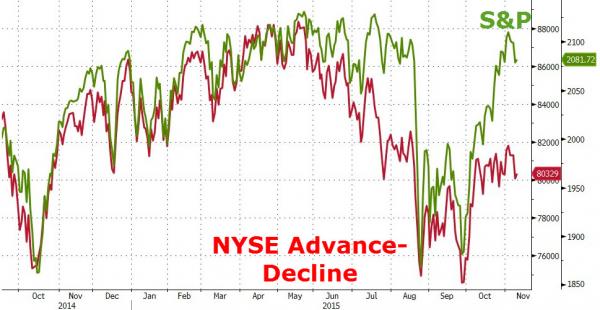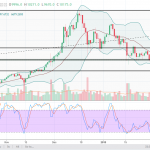Three days ago, just before the biggest market drop in weeks, we wrote an article attempting to answer “when does the market breakdown again” where we said the answer is in the advance-decline line….

… for one reason:the absolute collapse in market breadth had become the biggest threat to the rally since late September.
BofA noted that “the rise in the US Dollar has had a bearish impact on global equity market breadth (many equity markets have done much better in local currencies) and this A-D line has not confirmed the global equity market rally. This is a major bearish breadth divergence and a classic sign of diminishing breadth for global equity market indices.”
We added that what this “means that the central banks, whose only mandate is to keep the global market from crashing, is they will have to buy – either directly like the SNB and BOJ or indirectly/spoof like the NY Fed via Citadel – much more than just the E-mini and a handful of stocks to give the impression that the market is healthy when in fact, it is not.”
For now they are failing.
Which explains why suddenly the topic of collapsing market breadth is the biggest concern among Goldman’s clients.
As Goldman’s David Kostin explains, narrow market breadth has been a recent topic of investor discussions.
In other words, BTFD is nothing new.
But is breadth a relevant indicator? That depends: just like there has not been a major market crash without a Hindenburg Omen, so market breadth has collapsed before every single prior recession. However, just like the H-Omen, breadth has had numerous false negatives, and 8 very narrow breadth periods ended without an economic contraction. To wit:
On its own, narrow breadth is an unreliable indicator of a recession or market peak. Breadth was extremely narrow preceding each of the three recessions during the last 30 years, but the remaining eight narrow breadth periods ended in relatively healthy growth environments. While breadth was especially narrow before the market collapses of 2000 and 2007, the S&P 500 exited 7 of the 11 narrow breadth episodes in a positive fashion, with the median episode producing 6- and 12-month returns of 3% and 9%. In short, narrow breadth by itself does not appear to be a cause for investor concern.














Leave A Comment